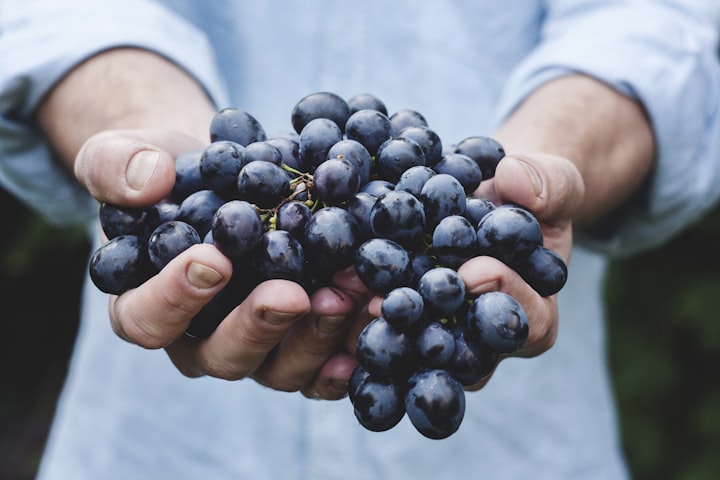The Strange Underground World of Produce Theft
Millions of dollars of produce are stolen every year and sold on the black market

While I browsed an article in the Atlantic about the Cannes Film Festival jewel heists, I ran across a link to a similar piece. “The Great Virginia Grape Heist” jumped off the page. What in the world is a grape heist? How exactly does that work? Intrigued, I read the article and dropped down a rabbit hole I didn’t know existed: the high-paying underworld of produce theft.
Let me set the scene
You have a secluded avocado orchard with no fences, cameras, or security of any kind. You can see the fruit. It’s like leaving your curtains open at the Holidays for all to see your tree and gifts, or perhaps leaving your purse or wallet in plain view in your car. In agricultural areas, it’s normal to see a large truck transporting produce. No one ever wonders if the product is stolen. It’s just too easy.
The original article that piqued my interest took place in 2018 on Firefly Hill Vineyards in Virginia. David Dunkenberger, co-owner of the vineyard in question, woke eagerly to harvest the year’s harvest before the backwash of Hurricane Florence swept through. But the 2.5 tons of grapes David had expected to see were gone.
When all was said and done, David calculated that $50,000 worth of profits had been swiped, equaling 1,200 bottles of wine. Considering the nature of the crime, David had nowhere to look but professional vintners. It didn’t seem possible that amateurs could pluck three acres of grapes so quickly. The job would have likely taken a crew of seven pickers, wearing headlamps, six hours, and at least two pickup trucks to haul away the grapes. Wine grapes are far too sweet for general consumption and require processing within the first 24-hours of being picked. This would mean someone local, a neighboring vineyard, had stolen his crop.
Not a New story
Produce theft has been taking place since farming began nearly 10,000 years ago. In 2014, a translation of a 4th-century Egyptian papyrus told of wine thieves and the guard who fended off criminals high-tailing it with his master’s crop.

Today, many farmers are under contract to produce crops. If the weather turns or crops don’t mature as expected, the difference comes out of the farmer’s pocket, or they don’t get paid. In the case of Firefly Hill Vineyard’s theft, the weather had been wetter than usual that year, ruining many of the surrounding grape crops. David reasons that someone in the area needed to make up the difference of their own lacking grape crop and helped themselves to his grapes to fulfill their contract.
Issues of Climate Change
The unpredictability of weather patterns doesn’t do farmers any favors. With sudden, uncharacteristic frosts in late spring and dryer, hotter summers, unprecedented rains, and flooding, these types of produce thefts are on the rise.
European Vineyards Targeted
On an autumn night in 2017, thieves swiped seven tons of grapes from the Bordeaux region of France. Police say the theft was precipitated by a bad growing season.
In addition to grapes, three of the vineyards had whole vines removed from the ground. In one instance, thieves uprooted 500 vines from a vineyard in Montagne, France. It takes a wine vine three years to produce fruits.
Pricey Produce
Wine grapes aren’t the only jewel produce thieves are after. How about citrus, nuts, and expensive avocados? Oh, you betcha.
Nut Heists and We're Not Talking Squirrels
You don’t have to be well-organized to make a good side hustle. With as little as a $50 Garden Weasle (a tool that helps you pick up nuts dropped on the ground) and eight free hours, someone can abscond with upward of 300 pounds of nuts like almonds, walnuts, pecans, or pistachios. All you have to do is shake the trees.
The Big Players
In 2016, over 30 truckloads of cashews, almonds, walnuts, pecans, and pistachios were stolen from Central Valley processors in California. The dollar amount on the thefts is around $10 million. The amount of produce stolen stunned both law enforcement and farmers. Usually, when produce goes missing, it’s a bucket or two, and it ends up at the local farmers' market.
Citrus Thieves
In 2018 in Seville, Spain, three vehicles were stopped carrying 9,000 pounds of citrus. When one of the van’s back doors was opened, a tidal wave of oranges spilled onto the road. The culprits, who were arrested, claimed they had been picking citrus all along the highway as they went. It turns out that the oranges were from a shipment that had gone missing from the docks.
Avo Heists
The price of avocados rose 40% in just three months in 2017. Growers knew that this price rise would lead to an increase in theft. That’s what happened to a ripening facility in Oxnard, California. Three of the company’s employees were arrested and charged with stealing over $300,000 in avocados.
The Issue with Produce Theft
Unlike jewels or money, or art, produce can't be traced. There are no serial numbers. No bar codes. Hardly any security and almost absolute seclusion. If the thieves aren’t caught while transporting their bulky haul, the crime may never be solved. It’s easy to see people get away with these types of lucrative thefts.
Fraud, not Force
Most produce thieves have a deep understanding of the complex distribution network surrounding the product. For example, say Costco orders several thousand pounds of almonds from a grower. Costco doesn’t have enough trucks, so they outsource for deliveries.
Along the way, thieves infiltrate the chain between buyer and seller, setting up fake companies and getting bids, or they create fake paperwork or alter existing paperwork, all the time ensuring that legitimate product ends up on the black market. Sometimes drivers don’t even know they're part of a scam. This is what happened in the case of the nut thefts in California’s Central Valley.
Sources
Atlantic, Guardian, Quartz, The Drinks Business, VCStar
Author's Note: I am an award-winning short story writer working on editing my first full-length novel. I am the former host of Demiworld, a dark podcast that examined the underbelly of society. I live in Portland, OR with my husband, son, and two cats.
If you enjoyed this article, please consider clicking the heart.
More articles like this
Are you thinking about sighing up for Vocal+? Follow the link below to get a reduced price on your first month.
About the Creator
Cynthia Varady
Aspiring novelist and award-winning short story writer. Hangs at Twtich & Patreon with AllThatGlittersIsProse. Cynthia resides in Portland, Oregon, with her husband, son, & kitties. She/Her






Comments
There are no comments for this story
Be the first to respond and start the conversation.